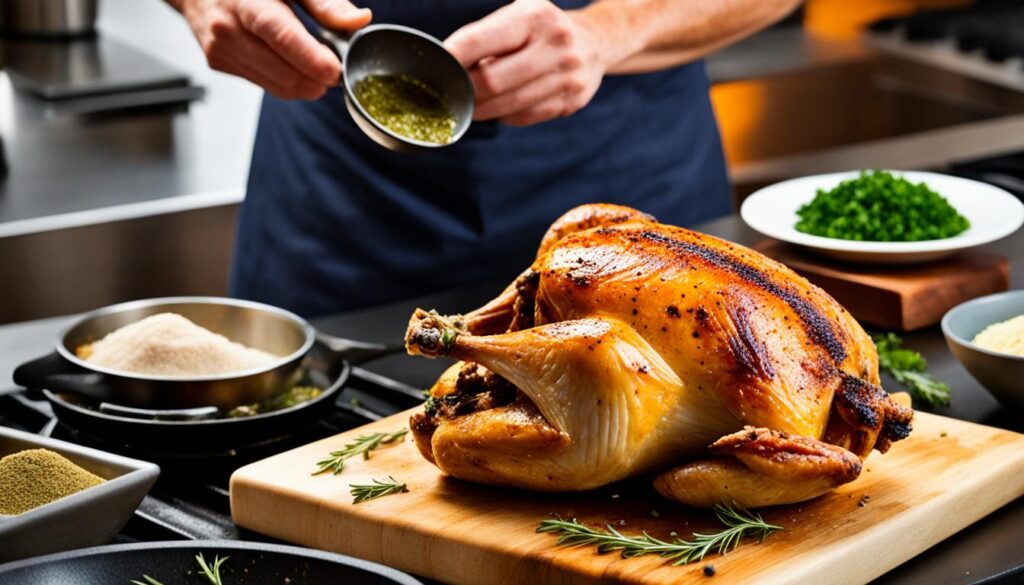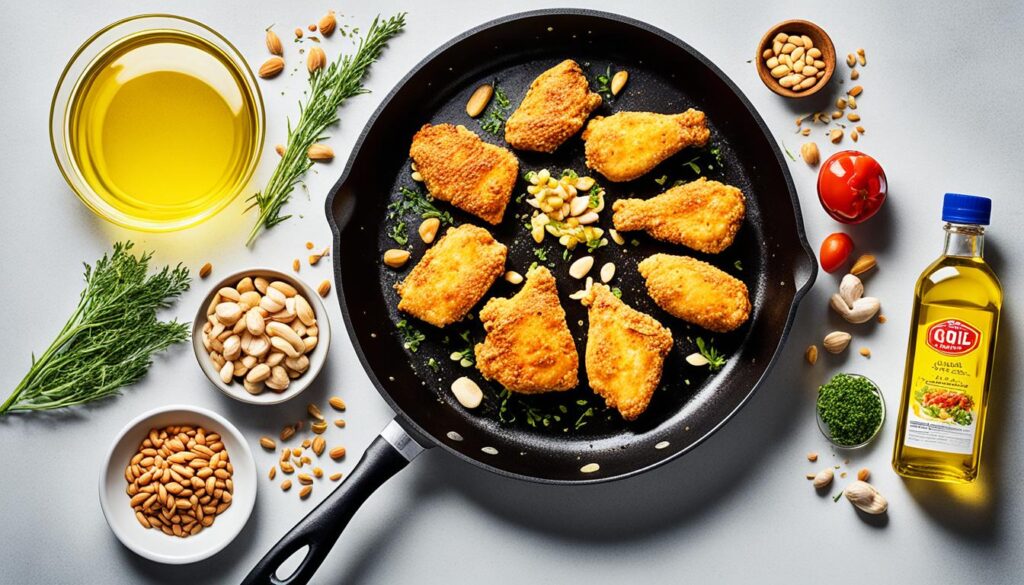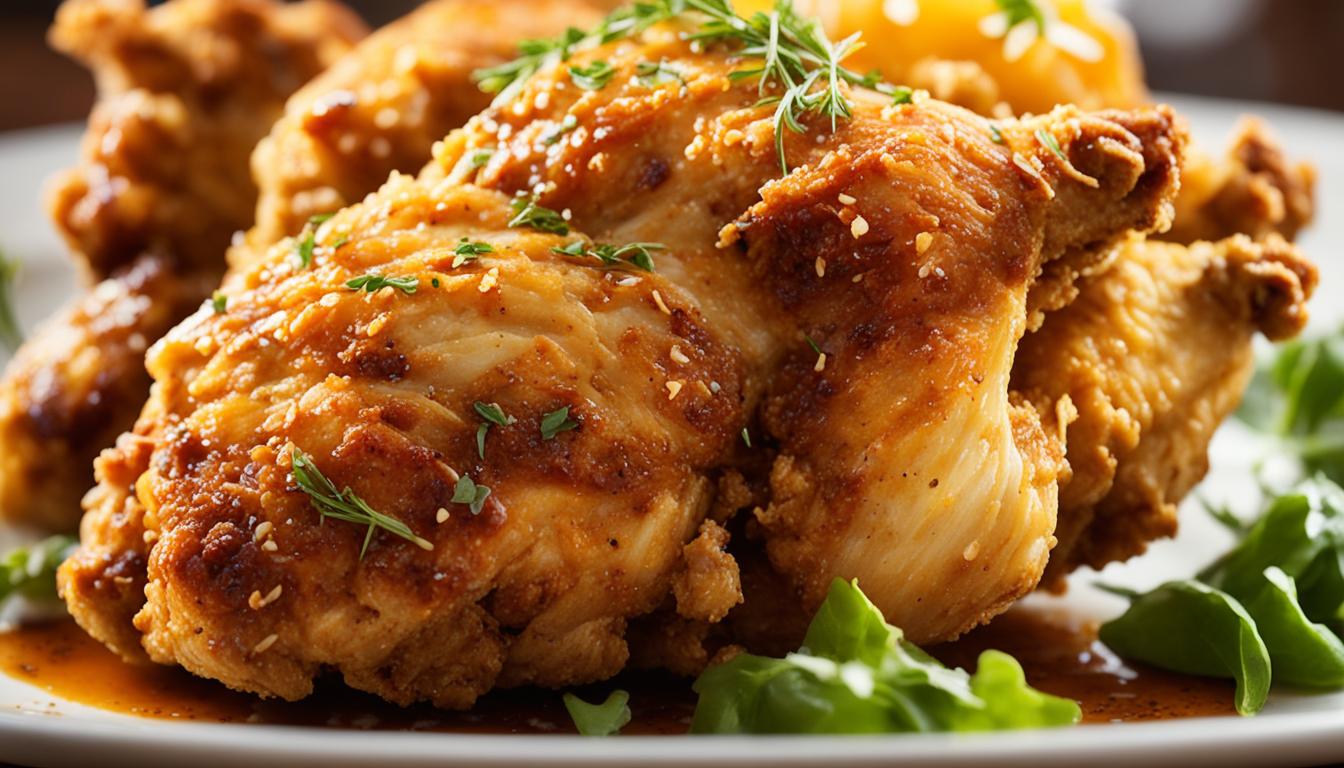Are you tired of mediocre, lackluster fried chicken? Do you dream of achieving a perfectly crispy, flavorful bite that leaves you craving for more? Look no further! We are about to reveal four secrets that will take your fried chicken game to new heights.
Whether you’re a seasoned cook or a novice in the kitchen, these secrets will help you create a fried chicken masterpiece that will wow your taste buds and impress your friends and family. From the perfect brine to the ideal coating, we’ve got you covered with tips and techniques that will revolutionize your fried chicken recipe.
So, are you ready to unlock the secrets to better fried chicken? Let’s dive in!
Key Takeaways:
- Discover four secrets to elevate your fried chicken game.
- Learn the importance of a well-seasoned brine or marinade for flavor and moisture.
- Understand the role of the coating in creating a crispy exterior.
- Master temperature control and oil quality for the perfect crunch.
- Discover the importance of resting your fried chicken for maximum crispness.
The History and Tradition of Fried Chicken
Fried chicken has a rich history and cultural significance that extends across continents. It has become synonymous with comfort food and is enjoyed by people of all backgrounds.
The tradition of frying chicken dates back to West Africa, where it was seasoned and cooked using frying techniques. When brought to the American South, these West African techniques merged with Scottish frying methods, resulting in the creation of classic Southern fried chicken.
“Fried chicken represents the frugality and resourcefulness of African American cooks who transformed inexpensive cuts of chicken into a flavorful and satisfying meal.”
African American cuisines played a significant role in perfecting and popularizing fried chicken. African American cooks used their culinary skills and creativity to develop unique seasoning blends and cooking techniques, turning fried chicken into a symbol of tradition and cultural identity.
Throughout history, fried chicken has evolved and taken on different regional characteristics and flavors. From buttermilk brining to special seasoning blends, every cook puts their own spin on this beloved dish.
The Cultural Significance of Fried Chicken
Fried chicken has transcended its humble origins and become deeply ingrained in American culture. It is often associated with Southern soul food, picnics, and family gatherings.
During the era of slavery, fried chicken was a source of nourishment and a way for African Americans to preserve their traditions and cultural identity.
Today, fried chicken is enjoyed across the country and is recognized as a quintessential American dish. It continues to bring people together and is often associated with warm memories and celebrations.
A Journey of Flavors and Traditions
The history and tradition of fried chicken highlight the culinary ingenuity and cultural contributions of different communities. It serves as a reminder of the resilience and creativity of those who shaped its evolution.
As we continue to savor every crispy, flavorful bite, let us appreciate the stories behind this beloved dish and the diverse cultures that have made fried chicken a timeless classic.
Selecting the Right Chicken
When it comes to preparing the perfect fried chicken, choosing the right chicken is the foundation for success. The type of chicken you select can greatly affect the flavor, texture, and overall outcome of your dish. Let’s explore the key factors to consider when selecting the ideal chicken for fried chicken.
Bone-In Chicken Cuts
Bone-in chicken cuts, such as thighs, drumsticks, and wings, are preferred for frying. These cuts offer several advantages that contribute to a delicious end result. Firstly, bone-in cuts retain more moisture during cooking, resulting in a juicier and more flavorful chicken. The bones also add depth of flavor to the meat, enhancing the overall taste profile. So, when shopping for chicken, opt for bone-in cuts to elevate your fried chicken experience.
White Meat vs. Dark Meat
White meat and dark meat have distinct differences in taste and texture. White meat, found in the breast and wings, tends to be leaner and milder in flavor. It has a delicate, tender texture but can easily dry out if overcooked. On the other hand, dark meat, present in the thighs and drumsticks, offers a richer, more pronounced flavor. Dark meat is also more forgiving in terms of cooking time, remaining moist and tender even if slightly overcooked. Consider your preference for flavor and texture when choosing between white meat and dark meat for your fried chicken recipe.
Freshness of Chicken
The freshness of the chicken is paramount to achieving the best results in fried chicken. Fresh chicken, preferably never frozen, guarantees superior texture and flavor. When purchasing chicken, look for plump, firm cuts with a pinkish hue. Avoid any signs of discoloration, strong odors, or sliminess, as these are indications of poor quality or spoilage. Fresh chicken ensures that your fried chicken will have the best possible taste and texture, so prioritize freshness in your selection.
By carefully selecting the right chicken for your fried chicken recipe, you lay the groundwork for a mouthwatering and memorable dish. Opt for bone-in cuts for moisture and flavor, consider your preference for white meat or dark meat, and always prioritize the freshness of the chicken. With these factors in mind, let’s move on to the next section and explore the essential steps for preparing the chicken.
Preparing the Chicken
Proper preparation of the chicken is essential for achieving a crispy and flavorful result. Here are key steps to follow:
Brining the Chicken
Brining the chicken in a saltwater solution helps enhance moisture and tenderness. To brine the chicken:
- In a large bowl, dissolve 1/4 cup of salt in 4 cups of water.
- Submerge the chicken pieces in the brine and refrigerate for at least 1 hour, or overnight for optimal flavor.
- Rinse the chicken thoroughly and pat dry before continuing with the next steps.
Marinating the Chicken
Marinating the chicken in buttermilk or other flavorful liquids adds extra flavor and tenderizes the meat. To marinate the chicken:
- In a bowl, combine the buttermilk with your preferred seasonings, such as garlic powder, paprika, onion powder, and black pepper.
- Add the chicken pieces to the marinade and make sure they are fully coated.
- Cover the bowl with plastic wrap and refrigerate for at least 1 hour, or overnight for maximum flavor infusion.
Drying the Chicken for Frying
After marinating, it is important to allow the chicken to dry properly, as wet chicken can lead to a less crispy exterior. To dry the chicken:
- Remove the chicken from the marinade and place it on a wire rack set over a baking sheet.
- Let the chicken air dry in the refrigerator for at least 1 hour. This helps remove excess moisture and promotes better browning during frying.
Creating the Perfect Coating
Creating the perfect coating is essential for achieving the desired texture and flavor. Here’s how to do it:
- In a large bowl, combine flour, your preferred seasonings, and cornstarch.
- Dredge the dried chicken pieces in the flour mixture, making sure they are evenly coated.
- Shake off any excess flour and let the coated chicken rest for a few minutes to allow the coating to adhere.
Follow these steps to properly prepare the chicken before frying, and you’ll be on your way to creating deliciously crispy fried chicken.

Mastering the Frying Technique
The frying technique is a critical step in achieving the perfect fried chicken. To ensure success, it’s important to consider various factors, including choosing the right oil for frying, maintaining the optimal oil temperature, preventing soggy fried chicken, and exploring alternative cooking methods for a healthier approach.
Choosing the Right Oil
When it comes to frying chicken, selecting the right oil is essential. Oils with high smoke points, such as peanut oil or canola oil, are ideal for deep frying. These oils can withstand high temperatures without breaking down, resulting in crispy and delicious fried chicken.
Optimal Oil Temperature
Maintaining the proper oil temperature is key to achieving a crispy exterior while ensuring the chicken is fully cooked. The optimal oil temperature for fried chicken is around 350°F (175°C). This temperature allows for even cooking and helps to seal in the moisture, resulting in juicy and flavorful chicken.
Preventing Soggy Fried Chicken
To prevent soggy fried chicken, it’s important not to overcrowd the pan. Cooking too many pieces at once can cause the temperature of the oil to drop, resulting in greasy and less crispy chicken. It’s best to cook in smaller batches to maintain the desired texture.
After frying, it’s essential to allow the chicken to drain properly. Placing the cooked chicken on a wire rack or paper towels helps remove excess oil, allowing the crust to stay crispy.
Alternative Cooking Methods
If you’re looking for a healthier approach to fried chicken, there are alternative cooking methods to consider.
Air frying is a popular option that utilizes hot air circulation to cook the chicken, resulting in a crispy exterior without the need for deep frying. This method requires minimal oil, making it a healthier choice.
Oven baking is another alternative method that produces crispy and flavorful chicken. By coating the chicken with breadcrumbs or a mix of flour and spices and baking it in a preheated oven, you can achieve a similar texture to traditional fried chicken with less oil.
Experimenting with these alternative methods allows you to enjoy the flavors and textures of fried chicken while making healthier choices.

| Oil Type | Smoke Point | Taste | Health Benefits |
|---|---|---|---|
| Peanut Oil | 450°F (232°C) | Mild and nutty | Rich in monounsaturated fats |
| Canola Oil | 400°F (204°C) | Neutral flavor | Low in saturated fat and high in omega-3 fatty acids |
| Vegetable Oil | 400-450°F (204-232°C) | Neutral flavor | Versatile and widely available |
Conclusion
By implementing these four secrets and following the tips and techniques discussed, you can elevate your fried chicken cooking game. From brining and marinating the chicken to creating the perfect coating and mastering the frying technique, each step contributes to achieving the ultimate crispy, flavorful fried chicken.
With practice and attention to detail, you can unlock the secrets to better fried chicken and impress your family and friends with a mouth-watering dish. So go ahead, grab your favorite chicken pieces and start perfecting your fried chicken recipe today.
